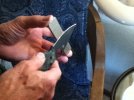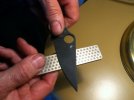- Joined
- Jul 17, 2016
- Messages
- 10
Having been advised to grind S110V on diamond to 600-800 and move to some diamond paste for light-to-medium stropping, I lack the clarity and information on that step of the process. I read around the forum that stropping high vanadium steels can work better on hard surface, but I'd like to clarify some information. Should I bother with the soft (suede) strops + diamond paste, or is it only going to work on hard strops? If so, could someone recommend a decent leather strop for steels like S110V?
Any info will be appreciated.
Any info will be appreciated.


